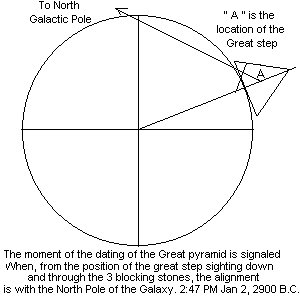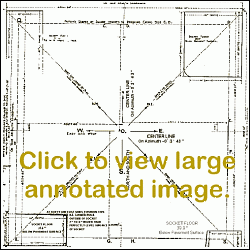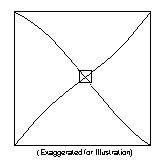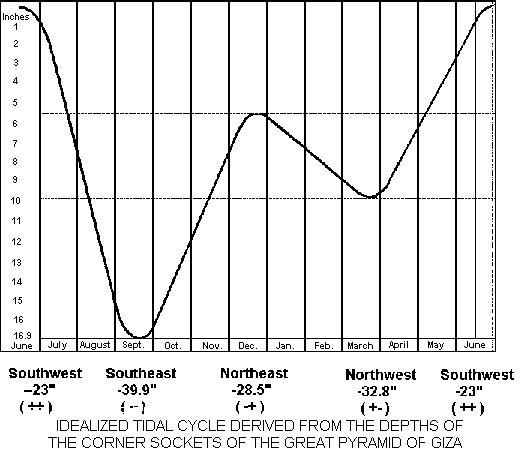[i] Though built at a later time, the design of the pyramid is linked to a precise time and date, signifying an instant in the rotation of the Galaxy. The pyramid commemorates an alignment, on earth and in time with the celestial position of the pole of the Galaxy. Orientation with the Galactic Pole fixes the angle of the Grand Gallery and its location within the pyramid. The alignment from the Great Step of the Grand Gallery toward the Galactic Pole would have gone through the earth at the precise moment. Three blocking stones at the base of the First Ascending Passageway were placed to indicate that "the way is blocked".
[ii]
The Pyramid models the solar system in the stones of the King’s Chamber
floor. Here 20 rectangular blocks lay out the Canon values for periods of
the first six planets and Earth’s Moon. In an upcoming section titled
The Well-Tempered Solar System /I> the lengths, areas and volumes of
the stones will be accorded as a table of the elements of the planets as
conceived by the pyramid architect.
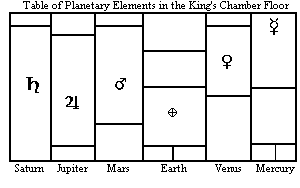
[iii] It shows the measurements of the lengths of the base sides of the pyramid, each side a different length. These measures are derived from Flinders Petri’s survey and the measures are from the very corners of the four cornerstones. Every pyramid study we have seen fails to take this uniqueness off length into account. Most authors average-out the lengths and produce identical lengths for the four sides. They contend that the pyramid builders "meant" for the sides to be identical. This is the grossest of distortions.
[iv] Diagram (exaggerated for illustration) representing the skewness of the aris edges as seen from the top of the pyramid looking down. Since the Pyramid courses are one for each year, we should expect that in 206 years the diagonal of the Pyramid on the topmost course (presently only 202 courses remain) will be shifted by about 2° 51.666’ representing the amount of the precession of the equinoxes in the 206 year period.
[v] Gravity is not Attraction. Water in its fluidity is able to readjust to any changes in motion. Picture a glass of water tilting right. The left side climbs the left side of the glass. Because the earth is participant in the celestial dance of all the planets and especially the proximity of the moon, the earth’s motion or vector is constantly shifting. Water on the planet sloshes, as in the glass. The record of this shloshing is an apparent response to the conventionally called "attraction to a distant mass."
When the framework considerations are attended, it can be shown that what appears to be "attraction" is the result of Earth’s changing acceleration/deceleration relative to a constant cosmic increase in velocity. The notion of an "attraction" can only be supported by observation in a local setting. The failure to acknowledge the macrocosmic acceleration leads to an assumption of attraction.
Although the discipline of contemporary science is committed to the notion of "attraction," there has never been an adequate explanation for "gravity" as an "attractive force". Framework manipulations, curved space or mathematical "displacements" of values attempting to explain attraction are finally unsatisfying. Worst of all, hypotheses about gravity fail to be adequately demonstrated.
"Attraction" is not necessary in the dynamics suggested here. What can be shown, as relevant to all motion, is the expansion and acceleration of all local framework elements, toward the direction of the star Regulus, i.e. the hidden attractor. More on this critical point later.
[vi] The measurements of the four corner sockets are translated into graph form, thus:
All natural cycles and rhythms have a form quite similar to this idealized graph. If we identify it with the tides then the 23 inch SW cornerstone is correlated with the plus high tidal phase, the 39.9 inch SE correlates with the low-low phase, the 28.5 inch depth of the NE with the minus-high phase and the 32.8 inch depth of the NW to the plus-high phase as shown. The chart depicts a universal mean of all cycles. In reality every cycle departs from this universal mean and this departure is what the stone courses and heights detail in fact.
[vii] The measurement of each one of these stones relates to the four functions in man which Jung calls the intuitive (the NE corner), the intellect or thinking, (NW), the feeling or emotional (SW), and the relational or sensational (the SE cornerstone). This systematics complements the four directions of the Indian Medicine Wheel—North, intuition; East, interrelationships; South, passion and will; West, thinking and introspection. The systematic is also complimented by the astrological attributes of water, air, fire and earth. Note: There is also a fifth socket located very close to the Southeast corner within the perimeter of the base. The timbre of its geometry relates to the wood of the I Ching and to the notion of synchronicity in Jungian Psychology. The geometry and mathematics of the corner sockets themselves are a textbook of psychology. The rendering of that model is beyond the scope of this present general exposition and will be elucidated elsewhere.
[viii] From here on our use of the term "magnetic" will have a special and noncoventional definition. The observation of the plus and minus activities of the magnet will be expanded from a local to a universal viewpoint. The conventional terms of "attraction" and "repulsion" are provincial notions promoted by local (meaning close-up) observation. When the factor of time is given its proper place in experimental equations it will be seen that "attraction" is a misnomer. It would be more accurate to state that objects, when seen in the continuum of time, become more closely aligned in their cosmodesic path. One object does not cause another to move toward it. Rather, both moving independently but in the same vector, converge. The science of magnetics cannot be considered separate of the affects of time and motion. More on this critical point will be addressed elsewhere.
[ix] Recall that our use of the term "inch" is a special case. However for the ease of the reader we will continue to refer to this special unit as an inch. The Canon Inch of the ancient builder integrates time and the performance of the pendulum. Albeit approximates the conventional inch in length, the Canon Inch is categorically quite distinct. It is the unit which harmonizes all metrological divergences. More detail can be found on the section regarding the Cannon of Measure.
[x] Smythe, Greaves, Taylor, Lockyer, Borchardt, to name a few.
[xi] Edgar, Davidson and Aldersmith, many others.
[xii] Another example: the height of the pyramid to the top of the 206th course (456.4375 feet) is intuitively suggested by the same "number" but of inches in one half the base side: 4564.375".
[xii] Ancient Arabic saying.
[xiv] The perimeter of the Pyramid is 36515 inches.
[xv] The height to the theoretical apex of the Pyramid would be 484.4444 feet. The tangent of one second of arc is .0000048444444.
[xvi] The Remen (17.47572816"), one form of the cubit, is part of the geometry of the SW corner. As the length of a rectangular space on the edge of the socket, it is found "outside" the pyramid. The rectangle extends to the edge of the sloping stone of bedrock on the edge and borders the perimeter line of the pyramid’s base on the side This rectangle has a width of one Remen. We call this geometry "The Keystone". It is located outside the pyramid and unlocks the stones within. The number of the Remen is also associated with the planet Mercury, an important element of the system. One divided by the Remen x 1000 is 57.22222. Taken as days this signifies the rotation period of Mercury. The degrees in the circle divided by the number of the Remen is the number of the common cubit as inches: 360 ¸ 17.47572816 = 20.6 inches. The Remen number x 10 is the number of years it takes the galaxy to rotate through one second of arc: 174.7572816 years.
[xvii] Years in one rotation of the galaxy, 223 million cannon years (360 days/year) divided by 100 = 2.23 million stones in Cheops approximately.
[xviii] The length of the base side of the pyramidian is 43.56127497 feet. 43.561274972 = 1897.584677 square feet in the base of the pyramidian. The indicated height of the pyramidian is 27.70787383 feet. Using these dimensions to find cubic volume, (square of base x height divided by 3) we derive a cubic volume for the pyramidian of 17526.01227 cubic feet. The natural logarithm of this volume is
9.771441472 = The number of inches in a one second pendulum. The initiation of the perfect top is derived from the length in inches of the 1-second pendulum. Note also that the number of feet on the base side of the pyramidian x 12 = 522.7352997 inches. The common logarithm of this number is 2.718281828, the base of natural logarithms.
[xix] The conventional figure is approximately 1521+/- feet Earth’s rotation at the equator in one second of time. The sacred figure of 1500 feet derives from 1521.451 ¸ K. Using 1500 ft/sec yields an Earth circumference of 25,000 Canon miles of 5258.16 feet per mile.
[xx] The Clarke Spheroid is approximately 24,901 miles of 5280 feet or 131,481,141.7 feet. A difference of about 5 miles in the total circumference, when compared to the Canon figure of 25,000 miles of 5258.16 ft/mile
[xxi] 365.15 ¸ 360 = 1.01430555
[xxii] 36515 ¸ 17.47572816 = 2089.469444 hours in Mercury’s orbit.
[xxiii] Said differently: When Mercury rotates through one degree of its circumference, Earth has rotated 57.2222 degrees. (During this interval, Venus has rotated through 14.30555 minutes of arc of its circumference.)
14.30555 ÷ 1000 + 1 = 1.01430555 or K )
[xxiv] Modern geodetic survey reckons 101.454333 feet/second of arc—a difference of .0237 feet.
[xxv] Modern geodetic survey reckons 6087.26 feet/minute of arc—less than 1.5 feet difference per minute.
[xxvi] Modern geodetic survey reckons approximately 69.17 miles/degree (5280 feet/ mile)—a difference of about 85 feet/degree relative to Canon measure.
[xxvii] 432 is a frequent referent in ancient writings: the Hindu cycle of the KaliYug is 432,000 years long. Both Persian and Biblical mythology, evoke 432. "His days shall be as 120 years." 360 x 120 = 43200.
[xxviii] 76.072238 x 10 is 760.72238 as feet indicates the mean side of Cheops’ base: 760.7291667 feet.
Interested parties may contact the authors, Bernard I. Pietsch,
and Suzanne Thompson by e-mail at: bernard @ sonic.net.
Top | Back
